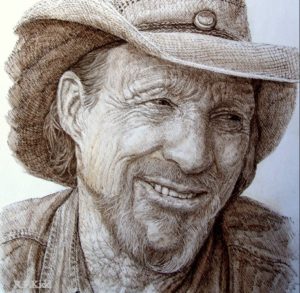
Meet the Artist: Robert Pace Kidd
A quest for solitude and love of art, a passion for the outdoors, both a cowboy and a surfer with a fascination for the life of indigenous people – meet Robert Pace Kidd.
Born in Minnesota in 1945, young Robert Pace Kidd moved with his family to Southern California shortly after the war. He grew up in Garden Grove when the town was a stop on the Pacific Electric Railway, a dozen city blocks surrounded by 75,000 acres of citrus groves – population 2400. By 1956, when the town incorporated, the population had exploded to 41,000 and would soon be named the “Fastest Growing City in America.”
Growing Up in Garden Grove
It was Robert, his father, George Dunlap Kidd, and his older brother living in a man’s world.
Robert learned to hunt and fish at his father’s side as they sought the outdoors. At home, Robert spent hours alongside his dad, while dad created masterpieces as a gunsmith and saddler. Robert grew up around horses, steeped in the culture of the American West.
But it was Garden Grove’s proximity to the beach – Huntington, Newport, and The Wedge – that captured young Robert Pace Kidd’s love for riding the waves. He became an avid surfer.
The Restless Years
Robert studied art history for a time at Orange Coast College and San Diego State University. In 1967, at the age of 22, Robert joined the United States Navy. The Vietnam War was raging and Seaman Robert Pace Kidd was destined for service in a mobile Underwater Mine Unit. Based in the Philippines, and later aboard aircraft carriers, he saw only limited duty in Vietnam. He did, however, meet the indigenous people of the Philippines and became fascinated by the similarities and differences with indigenous cultures in the American West.
Discharged from the Navy in 1971, Kidd came home restless. He was compelled by a sense of missing life and needing to wander. The desire to be “off the clock for a while” led to a rambling exploration of Australia, New Zealand and Indonesia, where – to finance his travels – he began selling portraits. Discovered there as a talented artist, encouraged by friends and eventually funded by a Chicago art dealer, Robert embarked upon a career in art.
When asked about the events that shaped his life, he points to the Christmas Eve cyclone that struck his boat off the island of Timor. Flat broke and reliant on the good will of friends, the event ended his oversees adventure.
The second event was the “Longest Walk” across America, a 1978 protest to raise awareness of the infringement of Native American rights, in which he participated. After watching a Lakota spiritual leader summon a thunderstorm on a cloudless day, Robert became a believer. His experiences on the walk gave him unique insights into Indian culture.
The Mature Artist
When asked about his proudest moments, he points to the 2004 Muramid event in Teotihuacan, Mexico. There he was an organizer and mentor of 1500 youth who drew almost 100 twelve-foot mural panels to add to the Art Miles Mural Project linking 500,000 people from 100 countries together through art.
Over a fifteen year period, Kidd developed a painstaking method for sculpting leather, introducing color with hand rubbed oils and sealing it with pigmented molten beeswax. The result is an enduring artwork impervious to dust, moisture, and pollutants that destroy other works of art.
Robert Pace Kidd works in multiple mediums. He stands alone as portrait artist working in leather. “I have never before seen a better fine arts use of leather than your work. The results achieved are almost beyond belief….” wrote one admirer. “Nobody recognizes it as leather!”
Decades of sculpting leather – with the tap, tap, tap of a hand held wooden mallet – took its toll. In 2014 Kidd’s right arm gave out and surgery left him unable handle the forceful repetitive motion leather sculpture requires. Not yet ready to retire, Kidd continues in pen and ink, as well as watercolor, creating one-of-a-kind art pieces along with commercial and Giclée reproductions of his signature art.
Fluent in four languages, Robert Pace Kidd resides in Rosarito Beach a few mile south of the international border with Mexico.
The Wieghorst Museum hosted a Robert Pace Kidd one man show in 2019 and invited him back as a visiting artist in 2021. His work will be on display through August 8, 2021.
